A significant and controversial change was made to 2005 NEC 240.86. This article is intended to provide electrical inspectors and others in the industry with background information and to explain how the new requirements in 240.86 can be met.
NEC110.9 requires overcurrent protective devices to have an interrupting rating that is sufficient for the nominal circuit voltage and the available short-circuit current at the line terminals of the device. Interrupting rating is defined as: the highest current at rated voltage that a device is intended to interrupt under standard test conditions. Fuses or circuit breakers that do not have adequate interrupting ratings can rupture violently causing damage to equipment and hazards to personnel as shown in photos 1 through 12 [Photos 1-6, Photos 7-12].
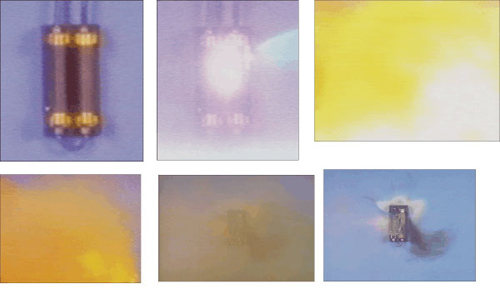
Photo 1-6. 600 V Class H fuse with a 10,000 amp interrupting rating applied at 480 V, with 50,000 amps available
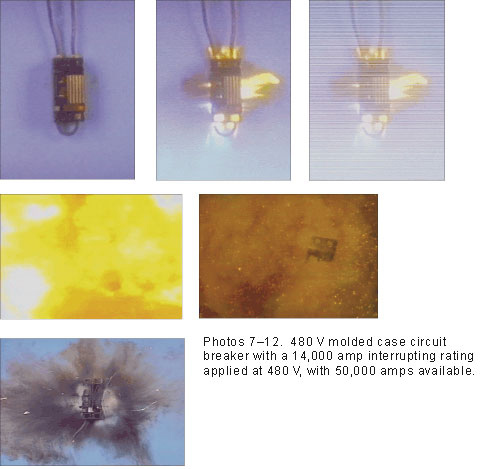
Photos 7-12. 480 V molded case circuit breaker with a 14,000-amp interrupting rating applied at 480 V, with 50,000 amps available
Fully Rated Systems
In a fully rated system, every overcurrent protective device has an interrupting rating equal to or greater than the available fault current at the line terminals of each device. Fully rated systems can be accomplished using properly rated fuses, circuit breakers, or a combination of fuses and circuit breakers. Fully rated systems are recommended, and can be used everywhere without restrictions.
Series Rated Systems — Tested Combinations
NEC 240.86 has an allowance for fuses or circuit breakers to protect downstream circuit

Figure 1. 240.86(B) and 110.22 factory and field labeling requirements for series ratings
breakers where the available short-circuit current exceeds the downstream circuit breaker’s interrupting rating. For new installations this is accomplished by using a tested series rated combination that has been evaluated for use in specific panelboards, loadcenters, and switchboards. There are many combinations of fuse/circuit breaker and circuit breaker/circuit breaker that have been tested and found acceptable for use in specific equipment. For new installations, where tested combinations are typically used, there is no need to “engineer” the system since so many solutions are readily available.
Series rated combinations are tested by a qualified recognized testing laboratory. For circuit breaker-circuit breaker combinations, the specific circuit breakers are tested. For fuse-circuit breaker combinations, special umbrella fuses protect the circuit breakers during testing. These umbrella fuses ensure that every commercially available fuse will be able to protect the circuit
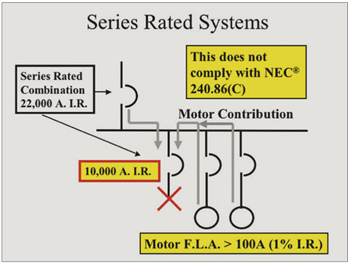
Figure 2. Motor Contribution Limitations
breakers. This means that if a specific circuit breaker is series rated with Class R fuses, a Class R fuse made by any manufacturer can be used. This includes both Class RK5 and Class RK1 fuses. It is important to note that Class RK1 fuses are more current-limiting than Class RK5 fuses; however, since they are the same physical size all series rated combinations are tested using Class RK5 umbrella fuses.
Series rated combinations have additional NEC requirements that must be satisfied. Switchboards and panelboards that are part of a series rated combination must be factory marked by the manufacturer with the series combination rating, and also have to be legibly marked in the field by the installer to indicate the equipment has been applied with a series combination rating per the 2005 NEC 110.22 and 240.86(B). See figure 1 for an example.
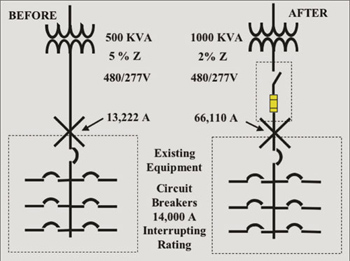
Figure 3. In this example, the existing building service is fed by a 500 kVA transformer that has a 5% impedance…
Series rated combinations are also subject to certain limitations and cannot be applied on all systems. Inherently, series rated systems are not selectively coordinated because the line side overcurrent protective must operate to protect the downstream circuit breaker. Therefore, they cannot be applied in any systems that are required to be selectively coordinated by the NEC. These systems include elevator circuits that have multiple elevators fed by the same feeder [2005 NEC 620.62], emergency systems as required in 2005 NEC 700.27, and therefore also in essential electrical systems in health care facilities, newly required by 2005 NEC 517.26, and legally required standby systems [2005 NEC 701.18].
Another limiting factor in applying series rated combinations is the motor load that is supplied by the system. The sum of the motor full-load currents connected on the load side of the higher rated overcurrent protective device and the on the line side of the protected circuit breaker
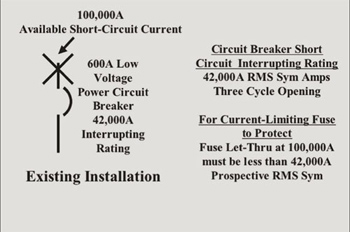
Figure 4. This illustrates an existing circuit breaker where the available short-circuit current exceeds the circuit breakers interrupting rating.
cannot exceed 1 percent of the protected circuit breaker’s stand-alone interrupting rating per 2005 NEC 240.86(C) (see figure 2). This is because running motors will momentarily contribute current to the fault. This added current can result in a short-circuit current in excess of what the protected circuit breaker can safely interrupt.
Series Rated Systems for Renovation or Expansion of Existing Facilities
Building electrical systems often change, sometimes drastically, after the initial installation. Quite often, changes to the electrical system, such as adding more capacity by increasing the kVA of the transformer, or installation of newer, more efficient transformers, result in higher available short-circuit currents. It is not uncommon for the increased available short-circuit current to exceed the interrupting of existing circuit breakers.
This is a serious misapplication that can result in equipment damage and safety hazards, and it is in violation of NEC 110.9. The 2005 NEC has a new alternative for existing installations that have circuit breakers that are applied in circuits with a higher available fault current than the circuit breaker’s interrupting rating. Prior to the code change in the 2005 NEC, the only option available to the owner was to scrap the existing equipment and install new circuit breakers or fusible switches that had adequate interrupting ratings for the increased available fault current. This is often cost prohibitive and disruptive. In many cases, the existing gear is not evaluated when a change is made to the service transformer or utility feed. Or, if it is evaluated, the owner decides to forego any upgrades because of the new equipment cost and disruptions to the operation of the business. This places electrical workers in a very hazardous situation if, and/or when, they must work on or near the improperly rated equipment.
It was with these concerns that NEC CMP-10 voted to allow for the use of an engineered series rated system for existing situations. The new wording reads:
“240.86 Series Ratings. Where a circuit breaker is used on a circuit having an available fault current higher than the marked interrupting rating by being connected on the load side of an acceptable overcurrent protective device having a higher rating, the circuit breaker shall meet the requirements specified in (A) or (B), and (C).
(A) Selected Under Engineering Supervision in Existing Installations. The series rated combination devices shall be selected by a licensed professional engineer engaged primarily in the design or maintenance of electrical installations. The selection shall be documented and stamped by the professional engineer. This documentation shall be available to those authorized to design, install, inspect, maintain, and operate the system. This series combination rating, including identification of the upstream device shall be field marked on the end use equipment.”
The new 2005 NEC 240.86(A) allows series rated combination for existing equipment to be selected by a licensed professional engineer. There are several options to protect the existing circuit breakers that have inadequate interrupting ratings:
1. Even though the existing system may not take advantage of series ratings, if the existing circuit breakers are not too old, the circuit breakers may have been series rated with upstream devices, but the equipment may have never been marked or the equipment may have a table or booklet that provides all the possible listed combinations of fuse-circuit breaker or circuit
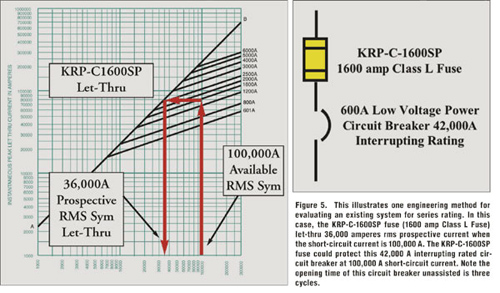
Figure 5. This illustrates one engineering method for evaluating an existing system for series rating.
breaker-circuit breaker series ratings. If so, a licensed professional engineer may be able to select a fusible switch or circuit breaker to be installed on the line side, that complies with one of these listed series rated combinations sufficient for the new available short-circuit current.
2. If the existing system utilized panelboards, loadcenters, or switchboards that were listed for use with specific tested series rated fuse/circuit breaker combinations, the testing was completed with commercially unavailable umbrella fuses. The licensed professional engineer may be able to utilize actual, commercially available fuses to provide equivalent or better protection. For example, if the existing system used series ratings with Class R fuses, a licensed professional engineer could analyze whether a specific fuse manufacturer’s RK1 fuse or Class J fuse may provide the protection at a higher short-circuit current. The series ratings for panelboards (where marked in a table or booklet) that are protected by Class R fuses have been tested with special Class RK5 umbrella fuses. An actual, commercially available Class RK1 fuse will have current-limiting let-through characteristics considerably less than the umbrella limits.
3. It should be noted that, at this time, there is not a generally accepted method to compare the let-though characteristics of a current-limiting fuse or current-limiting circuit breaker with the interrupting rating of modern molded case circuit breakers that exhibit dynamic impedance during the first ½ cycle after the initiation of a fault. But, a licensed professional engineer could supervise short-circuit testing with current-limiting fuses or current-limiting circuit breakers to verify the protection of circuit breakers that are identical to the installed, existing circuit breakers.
4. A licensed professional engineer can perform an analysis to determine if current-limiting fuses or current-limiting circuit breakers, installed on the line side of the existing circuit breakers, provide adequate protection for the circuit breakers. There are several methods to conduct this analysis depending on the circumstances. For instance, if the existing equipment consists of low-voltage power circuit breakers (approximately three cycle opening time), then the short-circuit let-through current of the line-side current-limiting fuse or current-limiting circuit breaker must be less than the existing, downstream circuit breaker’s interrupting rating. See example in figures 4 and 5.
When a method is used by a professional engineer to series rate existing circuit breakers, proper documentation is required. The documentation for the selection shall be stamped by the engineer and be readily available to those involved in the design, installation, inspection, maintenance and operation of the equipment. This requirement was developed to be the same as in 500.4(A). “This documentation shall be available to those authorized to design, install, inspect, maintain, or operate electrical equipment at the location.”
The equipment shall be field marked with the specifics of the series rating including specific manufacturer part numbers. This is the same as the requirement in 240.86(B) for tested combinations.
Note: A new 240.93, Series Ratings, is shown in the first printing of the 2005 NEC. It appears that this is a misprint and will be removed from future editions. The requirements of 240.86 apply to Part VIII, Supervised Industrial Installations. There are no special requirements or allowances in 240.93 for series ratings for supervised industrial installations.
In conclusion, there are two acceptable methods to meet the interrupting rating requirements of 110.9, fully rated systems and series-rated systems. In the interest of building and worker safety, the 2005 NEC has added another type of series-rated system, for existing installations, when selected by licensed professional engineers, stamped, and properly documented for use by all interested parties. For more information on series ratings including technical articles, a compliance checklist, and tested/listed fuse/circuit breaker combinations visit http://www.bussmann.com/apen/pubs/series.asp.













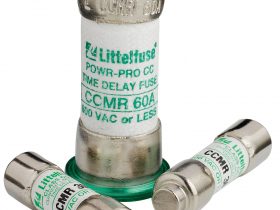
Find Us on Socials